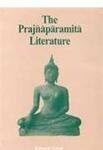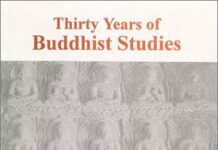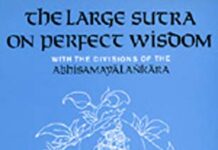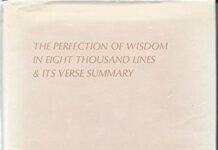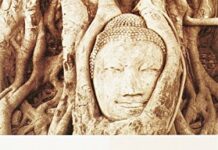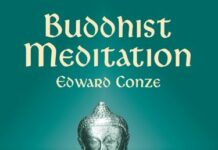
Ebook Info
- Published: 2014
- Number of pages: 338 pages
- Format: PDF
- File Size: 15.82 MB
- Authors: Edward Conze
Description
Edward Conze presents the premier anthology of Buddhist texts and scriptures in this stunningly ambitious collection. He traces the development of Buddhism through the ages, with translations from the original Pali, Sanskrit, Chinese, Tibetan and Japanese. For those looking for the perfect companion to Conze’s original text, Buddhism, or for those new to Buddhist theology, Buddhist Texts Through the Ages contains a thorough and comprehensive guide to the theology. This edition also includes a glossary of English and foreign terms.
User’s Reviews
Reviews from Amazon users which were colected at the time this book was published on the website:
⭐This excellent book might be thought of as a larger version of Edward Conze “Buddhist Scriptures”, which is not available in Kindle at this time (hint to Amazon!). “Buddhist Texts Through the Ages” is a wonderful resource for those meditators not turned off by what can seem to be pretty strange stuff. I got the paperback decades ago, and recently picked up the electronic version for the Kindle emulators on my PC and phone.This is the real deal, actual Buddhist texts as written long ago. Modern humanists should try “suspension of disbelief” for a while and give it a try. This is not Buddhism for Dummies, or new age happy talk / positive thinking. I strongly recommend that it be read in conjunction with something like Thich Nhat Hanh’s “Miracle of Mindfulness” which is authentic hard core Buddhism, but wisely written for our times.
⭐The only problem was it smells pretty musty, which was not stated in the write-up.
⭐Buddhist texts trough the agesEdward Conze, I.B. Horner, David Snellgrove and Arthur Waley are big names in Buddhology. As scholars they each represent a specific age and development in the history of Buddhist Thought.Horner, member of the Pali Text Society, which publishes primary and secondary sources of Early Buddhism, takes her share with `Part 1. The Teaching of the Elders.’ This part deals with canonical texts from the Theravada tradition and aims to sketch a picture of the Buddha by collecting small `crucial’ fragments from the suttas. The main emphasis falls on the Samgha, though, as this was Horner’s largest occupation. She also includes post-canonical works as the `Milindapanha’ (Questions of Milinda) and Buddhaghosa’s `Visuddhimagga’ (Path of Purity.)In the `Second Part. The Mahayana’ Edward Conze (Mahayana specialist) presents his selection of important Mahayana scriptures. Following the same theme as Horner, he too tries to `reconstruct’ the person of the Buddha, but, understandably, emphasising the symbolic function of the Buddha, proper to Mahayana exegesis. But he does more: he presents some of his own translations of the Ashtasahasrika-Prajnaparamita or `Perfection of Wisdom in Eight Thousand Lines.’ He also includes seminal texts of the Saddharmapundarika, more popularly known as the Lotus Sutra, and a biographical text of the Buddha called the Lalitavistara (`Played Verses’), both considered as early Mahayana texts. Other texts are, the Prajnaparamitasutra (`Perfection of Wisdom `) and the Sukhavativyuha (`Description of the Place of happiness`), all very important texts for the development of later Mahayanist philosophies as Madhyamaka and Yogacara.In the `Third Part. The Tantras’ David Snellgrove ((Tibetan) Tantric Buddhism specialist) gives his overview of Tantric Buddhism (often mistakenly linked in the West with solely sexual practices.) Starting with a selection of Aryadeva, the foremost disciple of Nagarjuna (Madhyamaka), he proceeds with the very interesting `Saraha’s Treasury of Songs.’ Other texts revolve primarily on practice and instruction. Not to forget Milarepa (11th-12th c.), the founder of the Kagyu-order.In the last `Part Four. Texts from China and Japan’, Arthur Waley gives us an interesting selection of texts that originated in India, were lost, but still exist in Chinese translations, of which I take the Yogacara Bhumi Sutra as an example. Text 208 tells an interesting story of a Hinayana sext in China. We have some texts of the `Dhyana-sect’ (p. 295, = Zen) en Japanese Tendai-school (Ch. T’ien-t’ai.) To finish, we have a glossary of Sanskrit terms and a list of abbreviations.So, what can we say about this book? It’s an interesting selection of the vast quantity of Buddhist texts of (most) schools. We have all the `phases’ covered in Buddhist history starting from Pali, over Sanskrit to Chinese and Japanese. The bibliography is moderately impressive and it’s admittedly a great task to make a good selection from the texts.To make a selection in only 306 pages urges one to be selective, and that’s where some texts unfortunately didn’t make in the selection: for example, a selection of the Mahavamsa would have enriched Part One.Some verses in the Second Part from the Nagarjuna’s `Mulamadhyamakakarika’ would have been nice to `embellish’ the change in philosophical ideas on the Dharma. There are too many Yogacara texts in my opinion.Part Three’s Saraha’s Treasury could have been a little bit more modest, now covering too many pages (15.) Part Four could have been so much richer if there were some texts from the Blue Cliff Record. Also texts from esoteric Chinese en Japanese Buddhist traditions like Hua-yen would have fitted nicely, not to mention Nichiren Buddhism. Also the terminology is a little bit outdated, showing the influence of Western interpretatory models, like `The Buddhist Apocalypse’ on page 45 (Don’t forget it’s a reprint from 1953.)Students of Buddhology would also profit from it greatly if the compilers had added some explanatory footnotes, like the historical background, political situation, implicit references, and the like. Now the reader is left to interpret himself. Some guidance would help the reader a long way.One last thing is that the texts are arranged in such a way that one might get the impression that we are talking about a historical evolution of Buddhist thought. This is not the case. Of course there is some chronology, but it cannot be sustained to claim the after one tradition the other one emerged. That is wrong. They existed, to some extent, simultaneous, represented in different schools and localities.All criticism aside, general readers will be fascinated by the richness of the Buddhist tradition, the shifting and developing of the meaning of the Dharma, the sometimes stunning interpretations done by later teachers,… It is a possible starting point for an introduction to primary sources and could serve, although critically, as a textbook for courses of Buddhism. But if you just like a good selection of texts to get an impression of what Buddhism is all about, then this bundle of wisdom will surely do.
⭐I have read many Mahayana and Vajrayana texts, most of a scholarly nature, but have found myself desiring the source of Buddha Dharma overall. To my joy, this book has served this purpose. Over 100 pages are words from the Buddha followed by writings from the other two turnings. The translation is very good.I highly recommend the teachings from the Muni himself to anyone who have been attracted to or caught up in the Mahayana, mindfulness, or Vajrayana wind that is sweeping through contemporary culture. Buddha’s words are the ground of it all.
⭐Edward Conze, I.B. Horner, David Snellgrove and Arthur Waley are big names in Buddhology. As scholars they each represent a specific age and development in the history of Buddhist Thought. Horner, member of the Pali Text Society, which publishes primary and secondary sources of Early Buddhism, takes her share with `The Teaching of the Elders.’ This part deals with canonical texts from the Theravada tradition and aims to sketch a picture of the Buddha by collecting small `crucial’ fragments from the suttas. The main emphasis falls on the Samgha, though, as this was Horner’s largest occupation. She also includes post-canonical works as the `Milindapanha’ (Questions of Milinda) and Buddhaghosa’s `Visuddhimagga’ (Path of Purity.)In the `Second Part. The Mahayana’ Edward Conze (Mahayana specialist) presents his selection of important Mahayana scriptures. Following the same theme as Horner, he too tries to `reconstruct’ the person of the Buddha, but, understandably, emphasising the symbolic function of the Buddha, proper to Mahayana exegesis. But he does more: he presents some of his own translations of the Ashtasahasrika-Prajnaparamita or `Perfection of Wisdom in Eight Thousand Lines.’ He also includes seminal texts of the Saddharmapundarika, more popularly known as the Lotus Sutra, and a biographical text of the Buddha called the Lalitavistara (`Played Verses’), both considered as early Mahayana texts. Other texts are, the Prajnaparamitasutra (`Perfection of Wisdom `) and the Sukhavativyuha (`Description of the Place of happiness`), all very important texts for the development of later Mahayanist philosophies as Madhyamaka and Yogacara.In the `Third Part. The Tantras’ David Snellgrove ((Tibetan) Tantric Buddhism specialist) gives his overview of Tantric Buddhism (often mistakenly linked in the West with solely sexual practices.) Starting with a selection Aryadeva, the foremost disciple of Nagarjuna (Madhyamaka), he proceeds with the very interesting `Saraha’s Treasury of Songs.’ Other texts revolve primarily on practice and instruction. Not to forget Milarepa (11th-12th c.), the founder of the Kagyu-order.In the last `Part Four. Texts from China and Japan’, Arthur Waley gives us an interesting selection of texts that originated in India, were lost, but still exist in Chinese translations, of which I take the Yogacara Bhumi Sutra as an example. Text 208 tells an interesting story of a Hinayana sext in China. We have some texts of the `Dhyana-sect’ (p. 295, = Zen), Japanese Tendai-school (Ch. T’ien-t’ai.) To finish, we have a glossary of Sanskrit terms and a list of abbreviations.So, what can we say about this book? It’s an interesting selection of the vast quantity of Buddhist texts of all the schools. We have all the `phases’ covered in Buddhist history starting from Pali, over Sanskrit to Chinese and Japanese. The bibliography is moderately impressive and it’s admittedly a great task to make a good selection from the texts. To make a selection in only 306 pages urges one to be selective, and that’s where some texts unfortunately didn’t make in the selection: for example, a selection of the Mahavamsa would have enriched Part One. Some verses in the Second Part from the Nagarjuna’s `Mulamadhyamakakarika’ would have been nice to `embellish’ the change in philosophical ideas on the Dharma. There are too many Yogacara texts in my opinion. Part Three’s Saraha’s Treasury could have been a little bit more modest, now covering too many pages (15.) Part Four could have been so much richer if there were some texts from the Blue Cliff Record. Also texts from esoteric Chinese en Japanese Buddhist traditions like Hua-yen would have fitted nicely, not to mention Nichiren Buddhism. Also the terminology is a little bit outdated, showing the influence of Western interpretatory models, like `The Buddhist Apocalypse’ on page 45 (Don’t forget it’s a reprint from 1953.)Students of Buddhology would also profit from it greatly if the compilers had added some explanatory footnotes, like the historical background, political situation, implicit references, and the like. Now the reader is left to interpret himself. Some guidance would help the reader a long way.One last thing is that the texts are arranged in such a way that one might get the impression that we are talking about a historical evolution of Buddhist thought. This is not the case. Of course there is some chronology, but it cannot be sustained to claim the after one tradition the other one emerged. That is wrong. They existed, to some extent, simultaneous, represented in different schools and localities.All criticism aside, general readers will be fascinated by the richness of the Buddhist tradition, the shifting and developing of the meaning of the Dharma, the sometimes stunning interpretations done by later teachers,… It is a possible starting point for an introduction to primary sources and could serve, although critically, as a textbook for courses of Buddhism. But if you just like a good selection of texts to get an impression of what Buddhism is all about, then this bundle of wisdom will surely do.
⭐A very authentic selection of Buddhist scriptural texts.However one wishes it be better organized in a more accessible and reader-freindly way.
Keywords
Free Download Buddhist Texts Through the Ages in PDF format
Buddhist Texts Through the Ages PDF Free Download
Download Buddhist Texts Through the Ages 2014 PDF Free
Buddhist Texts Through the Ages 2014 PDF Free Download
Download Buddhist Texts Through the Ages PDF
Free Download Ebook Buddhist Texts Through the Ages
